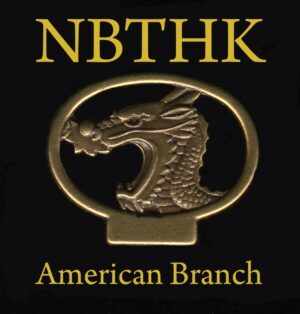Under construction and translation
Tōsō and Tōsōgu
About Tōsō and Tōsōgu
The exterior for carrying a sword is called Tōsō. And its parts are called Tōsōgu. These are a culmination of advanced techniques of sword artisans in each field.
Koshirae
Koshirae is a form of Tōsō. There are Tachi koshirae and Uchigatana koshirae, but there is a difference in how to wear around waist belt, and even the same part of the Tōsō, the names are conveniently differentiated by period and type.
Tachi Koshirae
① Kazaari tachi koshirae
② Sayajiri (Ishitsuki) ③ Nanatsukane ④ Obitori ⑤ Yamagatagane ⑥ Karatsuba ⑦ Fuchikanamono ⑧ Tsuka (Shirasame) ⑨ Kabutogane ⑩ Temekio ⑪ Tawarabyō ⑫Menuki ⑬ Kuchikanamono ⑭ Nagakazari
⑮ Hyōgokusari tachi
⑯ Semegane ⑰ Fukurin ⑱ Yaguragane ⑲ Hyōgokusari ⑳Tsuba ㉑ Tawarabyō ㉒ Tsuka (Shirasame) ㉓ Kabutogane (Tsukagashira) ㉔ Menuki ㉕ Fuchikanamono ㉖Kuchikanamono ㉗ Harubi ㉘ Sayajri (Ishitsuki)
㉙ Itomaki tachi koshirae
㉚ Saya ㉛ Ninoashi ㉜ Obitori ㉝ Ichinoashi ㉞ Tsuka ㉟Kabutogane (Tsukagashira) ㊱ Sarute ㊲ Tsukamaki ㊳Menuki ㊴ Tsuba ㊵ Sayakuchi (Kuchikanamono) ㊶Harubigane ㊷ Watarimaki ㊸ Kōragane ㊹Semegane ㊺Sayajiri (Ishitsuki)
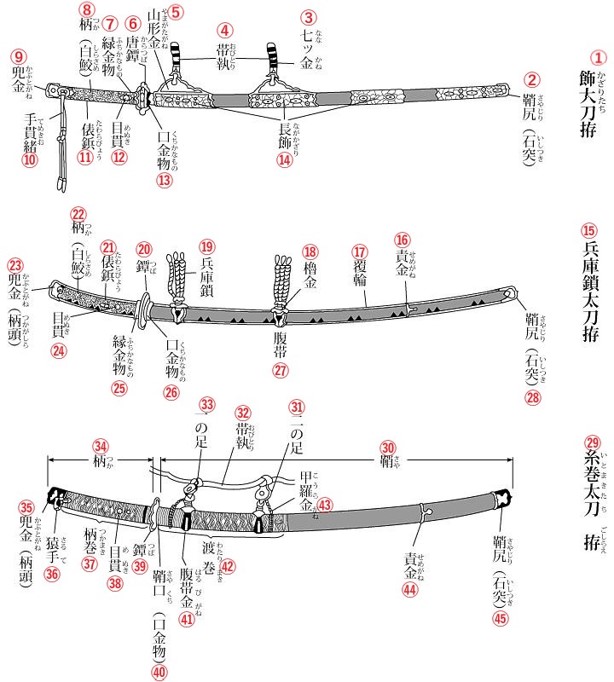
Uchigatana koshirae
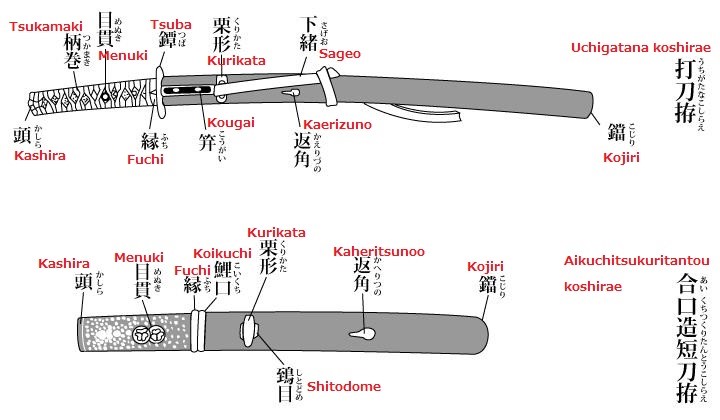
Tsuba
There are two types of Tsuba: One for Tachi, and other one for Uchigatana and Yōtō. The upper and lower positions of the Nakago–hitsu (center hole of Tsuba to put a sword) are reversed in both cases. Many Tachi tsuba were made before the Muromachi period, when Tachi koshirae were often used. There are leather Tsuba with thickly laminated layers of Nerikawa (treated leather which remains solid and light in weight) and Fukurin (rim cover of a tsuba), others are made of gilt-bronze or iron plate, large and thinly built or with thick Fukurin, or with Ōseppa (large washers). Depending on the shape, material, type, etc., there are Neri Tsuba, Aoi Tsuba, Mokkō Tsuba, and Kurumasukashi Tsuba.
Since the Momoyama Period, they were mainly Uchigatana tsuba, and Tachi tsuba was limited to ceremonial usage such as Itomaki tachigoshirae (with top of saya wrapped with thread). Uchigatana tsuba was made with various artistries depending on the region, school, creator, etc. Especially since the mid-Edo period, numerous metal Tsuba and props were made using various colored metals and metal engraving techniques, and many master craftsmen were produced.
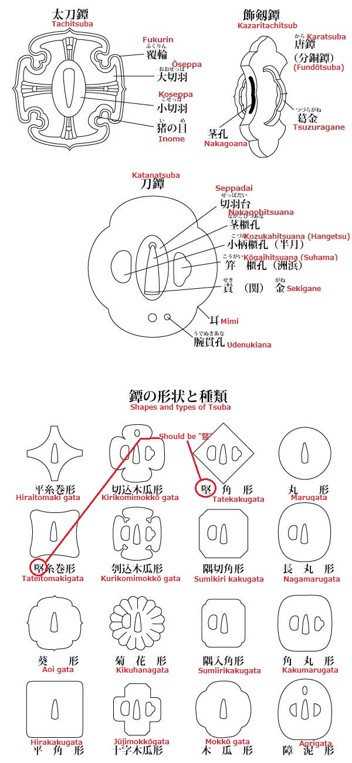
Tsuka
The handle part of sword. Since the early modern period, exclusively the magnolia obovata has been wrapped with white shagreen and wrapped with a wrapping technique called Hishi-itomaki. In past times, Yuzu and hardwood were used, and in ancient times, rhinoceros horn, rosewood, aloes wood, black persimmon, zelkova, bishopwood, and shagreen, etc. were used. Kuge tachi and Gijō tachi were not wrapped with Hishimaki technique, and Nameshigawa maki (tanned leather wrapping).
Itomaki (thread wrapping) were for samurai warrior class. Since the Sengoku period, the shark skin wrapped with Itomaki pattern has become a common custom. Sharkskin was often coated with black lacquer to withstand the rain and dew, and in addition to Nameshigawa and Hiragumi ito (flat braided thread), baleen and hemp thread wraps were also used.
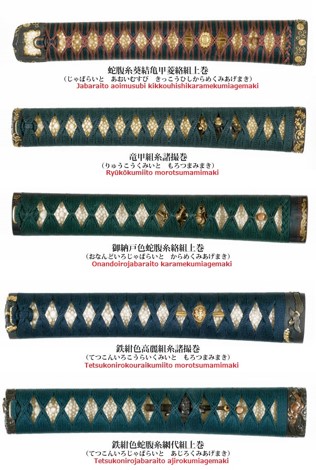
Saya
When wearing a sword, it is put in a Saya (scabbard), but in the old periods, there were some scabbards made of cowhide or bamboo, and later, more and more were made of magnolia obovat, and structured thinly.
After that, they got to be made thicker, and with leather wrapped scabbards and lacquered scabbards were often used. For the highly decorative Tachi koshirae of the Middle Ages, gilt bronze or silver etc. were used, and there were also Nishiki tsutsumi scabbards (wrapped with brocade cloth), Hirumaki scabbards (decorated with spiral bands of metals such as silver-plated copper, etc.), and Tōmaki scabbards (wrapped with calameae) and so on. As the material of the scabbard, leather wooden scabbards were used for ceremonial events, also Ikakeji, Raden, or Makie (all three are the technique of lacquerwork) were also used.
鶴足皮包葵紋散鞘殿中鐺打刀拵 (Tsuru ashi kawa tsutsumi aoi mon chirashi saya denchū kojiri uchigatana koshirae)
Lacquered scabbards were used exclusively for Uchigatana, Wakizashi, and Tantō in the modern era, but there were Black Roiro lacquered scabbards as Daisyō (a pair of the large and small ones) of the formal Samurai style. Additionally, engraved scabbards were used to prevent the slipping of the scabbards. Since the middle of the Edo period, engraving of metal fitting of Tōshō has become popular. Due to the influence of the townspeople’s culture, various types of Kawarinuri scabbards were developed in order to change the coating of Saya.
There were Togidashisame nuri, Kairagizame nuri, Aomijingai nuri, Isokusa nuri, Botanmon nuri, Mushikui nuri, Shuroke nuri, Take nuri, Ishime nuri, Rankaku nuri, etc., and Makie nuri was often used at the end of the Edo period.
The above scabbards were made using advanced lacquer painting techniques, and were highly artistic. The most common way in order to carefully store these Koshirae scabbards and to preserve the swords kept unused for long periods of time, is storing sword in a Shirasaya.
Shirasaya
Shirasaya (plain wood storage scabbard) has a name Shiraki no saya (bare wood scabbard), and is also called Yasume Saya or Abura Saya. It is important for a correct fitting saya as a scabbard out of alignment or the blade touches the scabbard, it will causes rust on the blade. The inside of the scabbard can also be damaged causing splinters which can scratch the blade. It’s also difficult to do Warizaya (splitting the scabbard) in order to remove the rust from the inside if it’s a lacquered scabbard or attached with any Tōsōgu, and the blade can be damaged. For this reason, separately a Shirasaya was developed for easier Warizaya and cleaning of the inside of the scabbard.
This was used in the early modern period, and in the early days, only Saya was replaced with another Shirasaya together with Tsuka of Koshirae and stored, but after modern times, it has started to be put in Shirasaya together with Tsuka and Saya. Shirasaya is made exclusively of magnolia obovata. Magnolia obovata is low in oil, and its wood quality is relatively uniform, soft and easy to process. The heart wood of the big tree is said to be the best.
Habaki
Habaki is the meaning of the waistcoat for the blade, and is also called Sayabashiridome or 腰巾金. It is located between the blade and Nakago (tang), and when combined with the Koi-kuchi part of Saya, the blade floats inside Saya and serves to support the blade from hitting the wood part of Saya.
There are Tachi habaki and Katana habaki. Some very old Tachi habaki are inserted from Kissaki and fixed at Tsuba, however, later, they have been all fitted from Nakakojiri and stopped there. Originally, it was made of iron by blacksmiths, and later on, copper, silver, gold, etc. were used.
Tetsu (iron) habaki is the original one and is highly valued as Tomohabaki. Tachi habaki does not have a Nomikuchi (ridge) of Mune (spine), and Katana habaki does have a Nomikuchi and there are single and double habaki. Kotō (old swords) often have double Habaki, and Shintō (new swords) single Habaki. In the Edo period, there are usually many copper-made Habaki without patterns, and silver and gold Habaki were used for Daimyo family swords and famous swords.
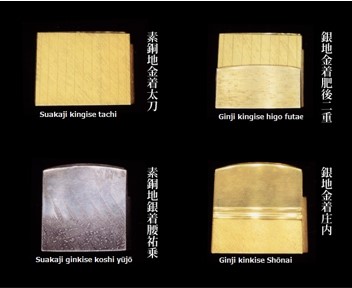
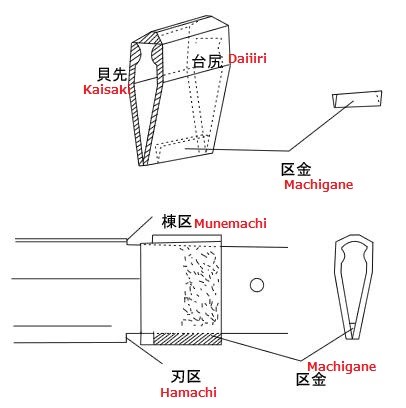
Since the modern era, exclusively gold Habaki has increasingly been used due to its gorgeous color and appeal. Since colored gold other than iron is used, Habaki was mainly made by artisans called Shiroganeshi. There are with gold layered Kinkise habaki and with silver layered Ginkise habaki, Mon habaki carved with family crests and patterns, as well as the ones with various types of processing such as Yūjō yasuri or Higaki yasuri, etc.
About materials and techniques of Tōshōgu
Various metal materials are used for sword fittings, depending on the social class of their user. Gold, silver and gilded metals are often used for ceremonial swords and swords for high ranking samurai families. Most of the samurai swords are made of iron and copper, and they are also lacquered for aesthetics and rust prevention.
Early modern Uchigatana and Wakizashi are often decorated with metal engraving techniques. In addition to iron, copper is made from Yamagane (unrefined copper) and Nigurome (copper alloy), and is further gilded. Often used is Yakigane (high-purity gold), Aokin (gold with silver alloyed) and Kobankin, and silverwork is also called the Nanryō.
Also alloy materials are used in the Edo period, such as Shakudō (red copper), Udō (copper and gold alloy), Shibuichi (silver and copper alloy), Rōgin (copper and silver alloy), and Shinchū (brass = alloy of copper and zinc), and so on. Shakudō is a metal material that has been used exclusively by the Goto family for props since the Muromachi period. The Nanakoji patterned plate carved the patterns on with Takanikubori technique, and a technique for representing gold and others in colored pictures is the features of their family carving.
Techniques vary depending on the shape of the Tsuba, props, etc., but there are several types of molding, including forging and Uchidashi carving. And as decoration techniques, there are Sukashibori, Keribori, Katakiribori, Nanakouchi, Takanikubori, Shishiaibori, Sukibori, Zōgan, Nunomezōgan, Hirazōgan, and so on.
Techniques for applying gold color include Kinkeshi mekki, Utsutori, Fukurokise, Kinkise, Kinzōgan, Kin nunomezōgan, Fukumikin, and they are called Kiniroe (gold-colored painting).
In addition to the Tsuba, the metal fittings used for Tōsōgu since the modern era include Fuchi, Kashira, Menuki, Kozuka, Kōgai, Habaki, Seppa, Kuchigane, Kurikata, Seme, Kojiri, etc. The fittings engraved decorations include Tsuba, Fuchi, Kashira, Menuki, Kozuka, and Kōgai, etc. Kozuka, Kōgai, and Menuki are called Mikoromono, and two types of metal fittings are called Futatokoromono and it was customary to separate them from the Tōsō koshirae in order to appreciate them. As a result, metal-carving techniques were developed as an art form and became one of the features of Edo art. Since the middle of the Edo period, many of these goldsmiths were produced, and each of them competed for the skills to make masterpieces, and holding appraisals had begun.
Appraisals and the Gotō family
During the Muromachi period, the paintings of the Tang dynasty were appraised by the Dōhō shū (the aides of Shogun and Daimyo, people who engaged in entertainment and civil service) of the shogunate.
The swords were appraised by the Honami family, and during the Keicho period, Honami Kōtoku appraised and Honami Kōshitsu issued Origami.
Appraisal of the fittings started with the works appraisal by the Goto family. The Goto family was descended from Gotō Yūjō, who served under Ashikaga Shogun Yoshimasa, and his descendants continued to lead the family to the end of the Tokugawa shogunate. Yūjō, Sōjō, and Jōshin‘s are Mumei (without sign carved), and it is said that they didn’t carved until the 4th generation Kōjō, but the existing works with Kōjō‘s signs are the ones with Kiwame-mei (Attribution by later generation) of the Goto family. Goto‘s appraisal Origami was issued for the first time since the 5th generation Tokujō. It is noteworthy that Tokujō was the first in the Goto family to make a Tsuba and to start using the ingot Shakudō for the first time. Some of the Mumei objects from the old eras after Yūjō were carved with Kiwame-mei by Kakujō, Teijō Mitsumasa, Enjō Mitsutaka, and Jujō Mitsumasa after the 7th Kenjo, and also the Origami were issued.
Tosogu and Fittings Terminology
Iron Schools – Tsuba 鐔
| Romanji | Kanji |
|---|---|
| Aizu shoami | 会津正阿弥 |
| Akao | 赤尾 |
| Akasaka | 赤坂 |
| Akita shoami | 秋田正阿弥 |
| Aoi | 葵 |
| Bizen shoami | 備前正阿弥 |
| Bizen-Yoshiro | 備前与四郎 |
| Bushu | 武州 |
| Choshu | 長州 |
| Daigoro | 大五郎 |
| Echizen | 越前 |
| Hayashi | 林 |
| Heianjo Zogan | 平安城象嵌 |
| Higo | 肥後 |
| Hikone Bori Soten | 彦根彫宗典 |
| Hirata | 平田 |
| Hoan | 法安 |
| Ito | 伊藤 |
| Kaga | 加賀 |
| Kagamishi | 鏡師 |
| Kaga-Yoshiro | 加賀与四郎 |
| Kamakura | 鎌倉 |
| Kanayama | 金山 |
| Kaneiye | 金家 |
| Katchushi | 甲冑師 |
| Kinai | 記内 |
| Ko-Tosho | 古刀匠 |
| Ko-shoami | 古正阿弥 |
| Kyo-shoami | 京正阿弥 |
| Kyo Sukashi | 京透 |
| Mito | 水戸 |
| Myochin | 明珍 明弥 |
| Myochin Ki | 明弥 紀 |
| Nanban | 南蛮 |
| Nara | 奈良 |
| Nishigaki | 西垣 |
| Nobuiye | 信家 |
| Onin | 応仁 (應仁) |
| Owari sukashi | 尾張 透 |
| Saotome | 早乙 |
| Shimizu | 志水 |
| Shoami | 正阿弥 |
| Shonai | 庄内 |
| Soten | 典 |
| Tachi Kanagu-shi | 太刀金具師 |
| Tachi-shi | 太刀師 |
| Tempo | 天法 |
| Tosa | 土佐 |
| Tosa Myochin | 土佐明珍 |
| Tosho | 刀匠 |
| Umetada | 埋忠 |
| Yagyu | 柳生 |
| Yamakichi | 山吉 |
| Yamakichibei | 山吉兵 |
| Yoshiro | 与四郎 |
Kinko Schools – 金工
| Ezo | 蝦夷 |
| Goto | 後藤 |
| Goto-Ichijo | 後藤一乗 |
| Hagiya | 萩谷 |
| Hamano | 浜野 |
| Higo Kinko | 肥後金工 |
| Hirata | 平田 |
| Ichinomiya | 一宮 |
| Inagawa | 稲川 |
| Ishiguro | 石黒 |
| Iwamoto | 岩本 |
| Kaga | 加賀 |
| Kano | 加納 |
| Katsura | 桂 |
| Kikuchi | 菊池 |
| Kikuoka | 菊岡 |
| Kinko | 金工 |
| Ko-Kinko | 古金工 |
| Ko-Mino | 古美濃 |
| Kono | 河野 |
| kusakari | 草刈 |
| Mino | 美濃 |
| Mito | 水戸 |
| Murakami | 村上 |
| Nara | 奈良 |
| Nomura | 野村 |
| Omori | 大森 |
| Otsuki | 大月 |
| Sano | 佐野 |
| Shoami | 正阿弥 |
| Shoami- Akita | 正阿弥秋田 |
| Someya | 染谷 |
| Tanaka | 田中 |
| Tetsugendo | 鉄元堂 |
| Tsuchiya | 土屋 |
| Umetada | 埋忠 |
| Yanagawa | 柳川 |
| Yokoya | 横谷 |
| Yoshioka | 吉岡 |
Koshirae – 拵
| Romanji | Kanji | Description |
|---|---|---|
| Aikuchi | 合口 | sword without tsuba |
| Banzashi-Daisho | 番差大小 | pair of swords worn during castle duty |
| Chiisagatana | 小さ刀 | tanto with tsuba and tsukamaki |
| Daisho | 大小 | paired swords, usually katana and wakizashi |
| Dashizame | 出し鮫 | same-covered sword handle without wrapping |
| Efu-Tachi | 衛府太刀 | used by imperial guards and high ranking officials of the shogunate |
| Fuchi | 縁 | fuchigashira |
| Fuchikashira | 縁頭 | fittings at the tip (kashira) and mouth (fuchi) of the handle |
| Futatokoromono | ニ所物 | 2 items, usually kogai and kozuka |
| Gaiso | 外装 | koshirae |
| Gangi-maki | leather strip handle wrap, may be lacquered over | |
| Gijo-Tachi | 儀仗太刀 | kazari-tachi |
| Gyakute | 逆手 | reversed grip (menuki) |
| Haichimonji-Tsuka | 刃一文字柄 | type of handle shape |
| Hamidashi | 喰出し | tanto with very small tsuba |
| Hamon | 刃紋 | pattern of the temper line of a blade |
| Han-dachi | 半太刀 | literal- half tachi, a katana mounted like a tachi without the hangers, worn edge up |
| Higo-Koshirae | 肥後拵 | koshirae from the higo province |
| Hirazukuri | 平造 | flat blade – no shinogi |
| Honoki | 朴ノ木 | magnolia wood |
| Horimono | 彫物 | carvings on the blade of the sword |
| Hoso-Tachi | 細太刀 | literal – narrow tachi |
| Hyogo-Kusari-Tachi | 兵庫鎖太刀 | tachi with chain-hangers |
| Imogata-Tsuka | 芋形柄 | handle shape |
| Itomaki no Tachi | 糸巻太刀 | tachi with cord wrapping on the tsuka and upper part of the saya |
| Jin-dachi | 陣太刀 | tachi for combat |
| Kaeri | 返り | hook on the scabbard to prevent it from slipping upwards |
| Kaeri-zuno | 返り角 | kaeri made of horn |
| Kaiken | 懐剣 | tanto for women |
| Kakemaki | 掛巻 | tsukaito crossed over the kashira |
| Kamishimozashi-Daisho | 裃差大小 | banzashi-daisho |
| Kanagu | 金具 | metal fittings of the koshirae; other terms are → tosogu or → kodogu |
| Kanto | 韓刀 | curved sword of korean origin |
| Kashira | 頭 | cap of handle |
| Katakiriha | 片切刃 | chisel-edge blade |
| Katana | 刀 | long sword (over 2 shaku) worn edge up |
| Katate-Uchigatana | 片手打刀 | katana for single-handed use |
| Kawazutsumi-Tachi | 皮包太刀 | tachi with a leather cover |
| Kazari-Tachi | 飾太刀 | literal- decorative tachi |
| Kenukigata-Tachi | 毛抜形太刀 | literal – hair tweezer tachi, cutout in nakago resembles such |
| Kinko | 金工 | soft / precious metal work |
| Kodachi | 小太刀 | tachi shorter than 2 shaku |
| Kodogu | 小道具 | small fittings |
| Kogai | 笄 | small knife in a pocket of the saya |
| Kogai-Hitsu | 笄櫃 | slot in the tsuba for the kogai |
| Kogatana | 小刀 | small knife for the kozuka |
| Koiguchi | 鯉口 | the opening of the scabbard |
| Kojiri | 鐺 | fitting at the tip of the scabbard |
| Koshigatana | 腰刀 | literal – hip sword, tanto |
| Koshirae | 拵 | mountings of the japanese sword |
| Kozuka | 小柄 | the handle of a small knife in a pocket of the saya |
| Kozuka-Hitsu | 小柄櫃 | slot in the tsuba for the kozuka |
| Kurigata | 栗形 | “chestnut shape”, stopper on the side of the scabbard through which the sageo goes |
| Kurourushi-Tachi | 黒漆太刀 | black lacquered tachi |
| Mei | 銘 | inscribed signature of the maker |
| Mekugi | 目釘 | fastening pin for the sword handle |
| Menuki | 目貫 | ornamental fittings on the handle |
| Mitokoromono | 三所物 | literal – things of 3 places: Usually menuki, kozuka and kogai |
| Monouchi | 物打 | striking part, upper 1/3 of the blade |
| Morozori-Tsuka | 諸反り柄 | handle shape |
| Mune | 棟 | spine of a blade |
| Muzori | 無反り | blade without curvature |
| Nagamakinaoshi | 長巻直し | naginatanaoshi |
| Nanako | 七子 | fish roe pattern on fittings |
| Nodachi | 野太刀 | literal – field tachi; very long tachi, odachi |
| Nurizaya | 塗り鞘 | lacquered scabbard |
| Obitori | 帯執 | the hangers of the tachi |
| odachi | 大太刀 | very long tachi → nodachi |
| O-Wakizashi | 大脇差 | very long wakizashi |
| Ryugo-Tsuka | 立鼓柄 | handle shape |
| Sageo | 下緒 | silk (typically) band that goes through the kurigata |
| Sakizori | 先反り | curvature is deepest toward the tip of the blade |
| Same | 鮫 | samegawa |
| Samegawa | 鮫皮 | ray skin |
| Samenuri | 鮫塗 | polished same with lacquered interstices |
| Saya | 鞘 | scabbard |
| Sentoku | 宣徳 | alloy of copper, lead and zinc |
| Seoi-Nodachi | 背負野太刀 | nodachi worn on the back |
| Seppa | 切羽 | spacers / washers for the tsuba |
| Shibuichi | 四分一 | silver and copper |
| Shikomizue | 仕込杖 | sword hidden in a walking stick |
| Shinogi-zukuri | 鎬造 | blade with a ridge on both sides |
| Shippo | 七宝 | cloisonné |
| Shirasya | 白鞘 | plain wooden storage scabbard |
| Shiri-zaya | 尻鞘 | fur cover for the scabbard |
| Shobuzukuri | 菖蒲造 | “iris leaf shaped” sword blade |
| Shogun | 将軍 | supreme military commander |
| Sunnobi-Tanto | 寸延短刀 | tanto a little longer than 1 shaku |
| Susudake | すす竹 | smoked, seasoned bamboo |
| Tensho-Koshirae | 天正拵 | koshirae of the tensho period |
| Tetsu | 鉄 | iron / steel |
| Toppei-Koshirae | 突兵拵 | koshirae worn with western cloths and military uniform |
| Tojozashi-Daisho | 登城差大小 | banzashi-daisho |
| Tosogu | 刀装具 | sword fittings |
| Tsuba | 鍔 | hand guard |
| Tsuba-gatana | 鍔刀 | chiisagatana |
| Tsuka | 柄 | handle |
| Tsukaito | 柄糸 | lace used for hilt binding |
| Tsukamaki | 柄巻 | hilt wrapping |
| Tsurugi | 剣 | different pronounciation for ken |
| Uchizori-Tsuka | 内反り柄 | type of handle shape |
| Urushi | 漆 | lacquer |
| Yagyu-Koshirae | 柳生拵 | a type of koshirae named after the yagyu family |
| Yasume-zaya | 休め鞘 | shirasaya |
Motif / Theme – 題
| Romanji | Kanji | Description |
|---|---|---|
| Shikunshi | 四君子 | the four nobles, plum, orchid, bamboo, chrysanthemum |
| Akigusa | 秋草 | autumn grasses. |
| Akimushi | 秋虫 | autumn insects |
| Akitsu | 秋津 | dragonfly – old word |
| Aki no nanakusa | 秋の七草 | seven flowers of autumn |
| Amime | 網目 | a net |
| Aoi | 葵 | hollyhock |
| Asagao | 舜 | morning glory |
| Awa | 粟 | millet |
| Awabi | 鮑 | abalone |
| Ayame | 菖蒲 | iris |
| Bamboo | 竹 | take (Japanese) |
| Baichiku | 梅竹 | plum and bamboo, Chinese pronunciation |
| Baika | 梅花 | plum blossom |
| Botan | 牡丹 | peony |
| Budo | 葡萄,ぶどう | grape |
| Chashaku | 茶杓 | a bamboo tea spoon used in the japanese tea ceremony |
| Chasen | 茶筅 | tea whisk. used in the tea ceremony |
| Chidori | 千鳥 | plover bird |
| Chigai taka no ha | 違い鷹の羽 | crossed hawk feathers |
| Chocho | 蝶々 | butterfly |
| Daikon | 大根 | a white radish |
| Donguri | 団栗 | acorn |
| Ebi | 海老 | a prawn (shrimp) or lobster |
| Ebôshi | 烏帽子 | a nobles court head gear |
| Enkenshô | 遠見松 | distant pines |
| Ensan | 遠山 | distant mountains |
| Fuji | 藤 | wisteria |
| Fuji | 富士 | mount fuji |
| Fujimaru Mon | 藤丸紋 | round wisteria mon |
| Fukuro | 梟 | owl |
| Fune | 船 | a boat |
| Gin | 金 | silver |
| Gunma | 群馬 | a group of horses |
| Haiku | 俳句 | Japanese poem |
| Hagi | 萩 | bush glover |
| Hana | 花 | flower |
| Hashi | 橋 | bridge |
| Hasuha | 蓮葉 | lotus leaf |
| Hato | 波濤 | waves or a rough sea |
| Hebi | 蛇 | a snake |
| Hibari | 雲雀 | skylark |
| Hôô | 鳳凰 | a pheonix |
| Inome | 猪の目 | a boars eye. this has the appearance of a heart |
| Ito Maki | 糸巻き | a spool for silk |
| Jôkaku | 城郭 | a castle |
| Yokai | 妖怪 | ghost |
| Kacho-ga | 花鳥画 | bird and flower |
| Kaizukushi | 貝尽し | a collection of sea shells |
| Kaki | 柿 | persimmon |
| Karigane | 雁金 | wild geese |
| Kuchinashi | 山梔子 | gardinia flower |
| Matsu | 松 | pine |
| Mino | 蓑 | a straw rain coat |
| Mokuren | 木蓮, 木蘭 | magnolia |
| Myoga | 茗荷 | Japanese ginger |
| Ougi | 扇 | folding fan |
| Obana | 尾花 | another word for autumn grass |
| Kaki | 柿 | persimmon |
| Paulownia | 桐 | a tree native to china, however in Japan for over 1000 years. used for shirasaya and fittings boxes. |
| Raimon | 雷文 | a pattern describing zigzag, usually refers to lightning. |
| Ran | 蘭 | Orchid |
| Sagi | 鷥 | Egret |
| Sakura | 桜 | Cherry tree |
| Shibazakura | 芝桜 | cherry grass |
| Shishi | 獅子 | classic Chinese lion, also referred to as a lion dog |
| Sho-Chiku-Bai | 松竹梅 | Pine, Bamboo & Plum, Chinese pronunciation |
| Sugegasa | 菅笠 | a straw hat |
| Suisin | 水仙 | daffodil |
| Suzume | 雟 | sparrow |
| Take | 竹 | bamboo |
| Tonbo | 蜻 | butterfly – modern word |
| Tsubaki | 椿 | camellia |
| Tsukashi | 透し鍔 | cut-out motif positive or negative |
| Uguisu | 鶯 | bush warbler |
| Ume | 梅 | Plum |
| Uzura | 鶉 | quail |
| Waka | 和歌 | Japanese poem |
| Yanagi | 柳 | Willow tree |
| Yatsuhashi | 八橋 | a classic theme of 8 bridges under which, iris are growing |
| Yuri | 百合 | Lily |
Other
| Gin | 銀 | silver |
| Kin (Kane) | 金 | gold / softer metals |
| Seido | 青銅 | bronze |
| Shakudo | 赤銅 | alloy of copper and gold |
| Shibuichi | 四分一 | copper / silver alloy |
| Suaka | 素銅 | vinegar red copper |
| Yamagane | 山金 | literal – mountain metal, unrefined copper |
| Zôgan | 象嵌 | Inlay. Mostly brass or copper. |
